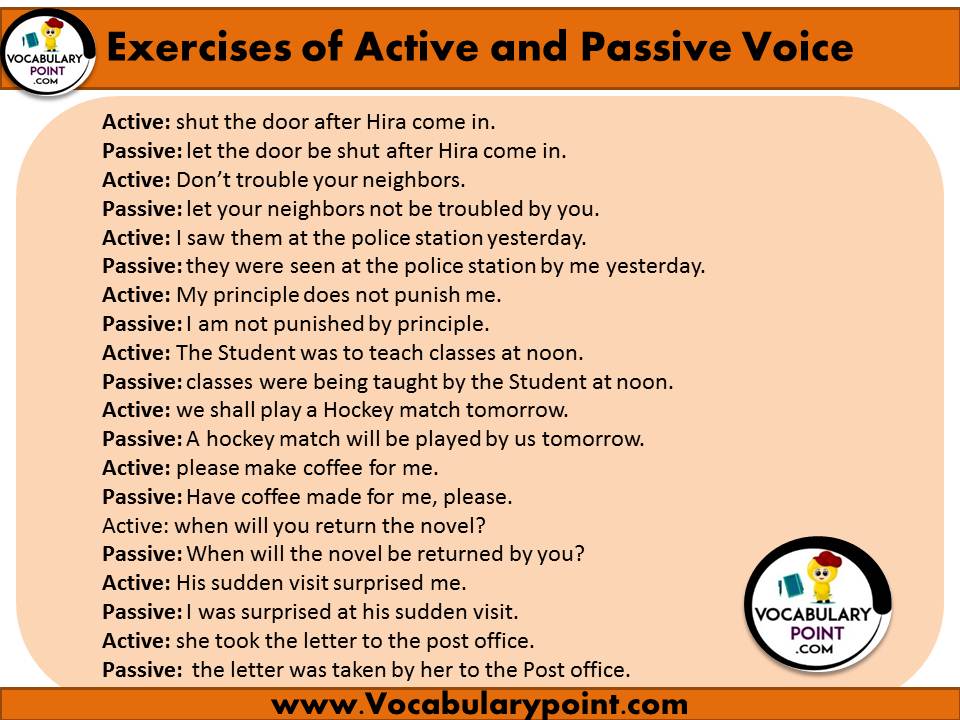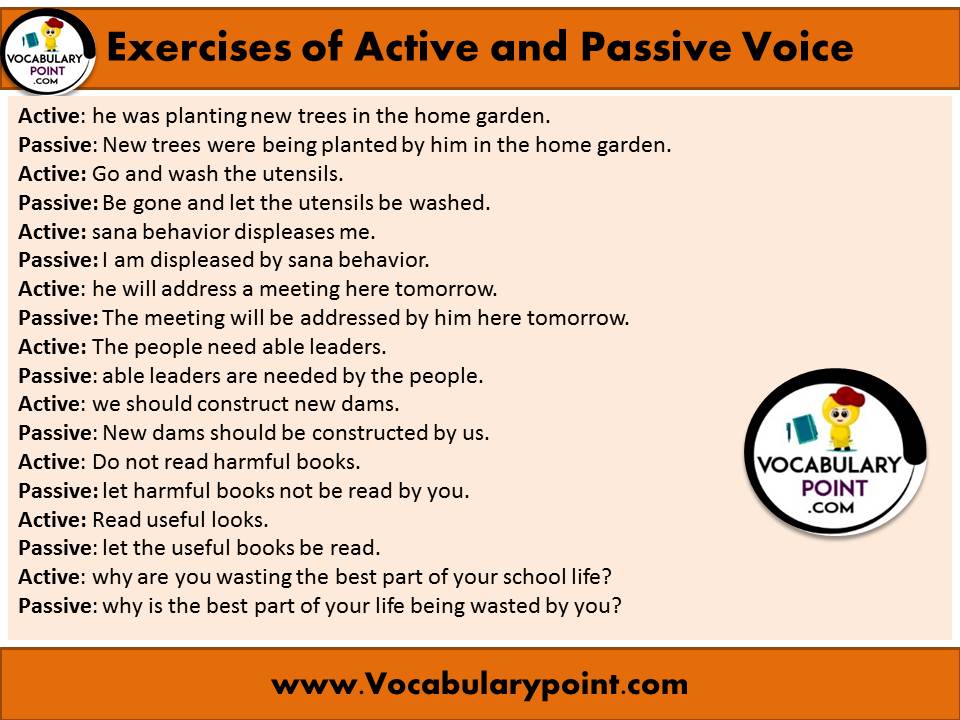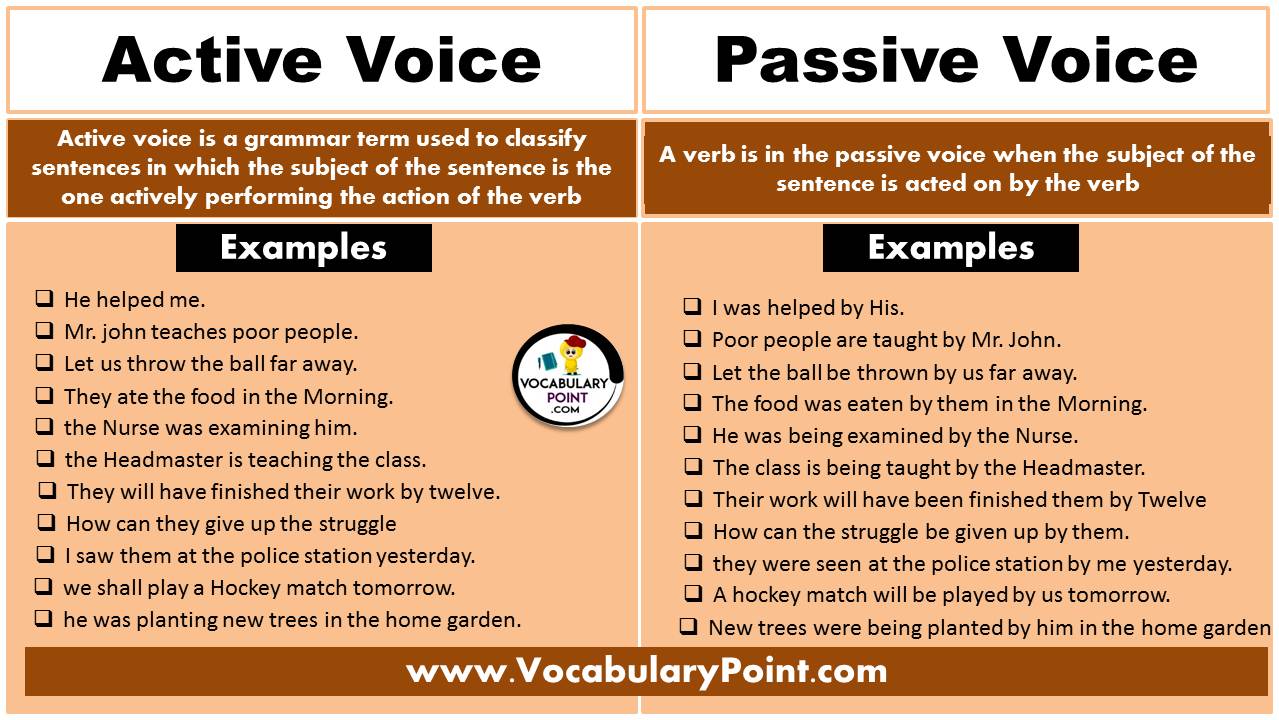Exercises of Active and Passive voice with Example, Learning to convert sentences between active and passive voice is a key skill for beginners studying English. Active voice is when the subject of the sentence performs the action described by the verb, making sentences direct and dynamic. Passive voice, on the other hand, emphasizes the action and the object receiving it, often omitting the doer of the action, which can make statements more formal or impersonal. This guide will provide exercises to practice changing active sentences into passive ones and vice versa, complete with examples to help clarify the process. Such practice is invaluable for improving your grammatical range and writing skills.
What is active voice?
In active voice, the subject performs the action expressed by the verb, leading to direct and concise sentences.
What is passive voice?
In passive voice, the action is emphasized over the subject, often relegating the doer of the action to a secondary role in the sentence.
Exercises Of Active And Passive Voice
- Active: The gardener plants the trees.
Passive: The trees are planted by the gardener.
- Active: The chef cooks the dinner.
Passive: The dinner is cooked by the chef.
- Active: The child paints a picture.
Passive: A picture is painted by the child.
- Active: The writer publishes a novel.
Passive: A novel is published by the writer.
- Active: The teacher assigns homework.
Passive: Homework is assigned by the teacher.
- Active: The driver honks the horn.
Passive: The horn is honked by the driver.
- Active: The scientist discovers a cure.
Passive: A cure is discovered by the scientist.
- Active: The athlete wins the medal.
Passive: The medal is won by the athlete.
- Active: The photographer takes a photo.
Passive: A photo is taken by the photographer.
- Active: The editor edits the article.
Passive: The article is edited by the editor.
- Active: The musician plays the guitar.
Passive: The guitar is played by the musician.
- Active: The student completes the assignment.
Passive: The assignment is completed by the student.
- Active: The judge delivers the verdict.
Passive: The verdict is delivered by the judge.
- Active: The baker bakes the cookies.
Passive: The cookies are baked by the baker.
- Active: The mechanic repairs the car.
Passive: The car is repaired by the mechanic.
- Active: The programmer codes the software.
Passive: The software is coded by the programmer.
- Active: The tourist visits the museum.
Passive: The museum is visited by the tourist.
- Active: The tailor sews the dress.
Passive: The dress is sewn by the tailor.
- Active: The author writes a sequel.
Passive: A sequel is written by the author.
- Active: The pilot flies the airplane.
Passive: The airplane is flown by the pilot.
- Active: The farmer harvests the crops.
Passive: The crops are harvested by the farmer.
- Active: The teacher explains the theory.
Passive: The theory is explained by the teacher.
- Active: The architect designs the building.
Passive: The building is designed by the architect.
- Active: The nurse administers the medication.
Passive: The medication is administered by the nurse.
- Active: The customer buys the product.
Passive: The product is bought by the customer.
- Active: The maid cleans the room.
Passive: The room is cleaned by the maid.
- Active: The lawyer argues the case.
Passive: The case is argued by the lawyer.
- Active: The florist arranges the flowers.
Passive: The flowers are arranged by the florist.
- Active: The lecturer discusses the topic.
Passive: The topic is discussed by the lecturer.
- Active: The children decorate the tree.
Passive: The tree is decorated by the children.
- Active: The cashier counts the money.
Passive: The money is counted by the cashier.
- Active: The actor performs the monologue.
Passive: The monologue is performed by the actor.
- Active: The artist exhibits the paintings.
Passive: The paintings are exhibited by the artist.
- Active: The secretary schedules the meetings.
Passive: The meetings are scheduled by the secretary.
- Active: The climber reaches the summit.
Passive: The summit is reached by the climber.
- Active: The sailor navigates the ship.
Passive: The ship is navigated by the sailor.
- Active: The broker sells the stocks.
Passive: The stocks are sold by the broker.
- Active: The diver explores the reef.
Passive: The reef is explored by the diver.
- Active: The hiker climbs the mountain.
Passive: The mountain is climbed by the hiker.
- Active: The coach trains the team.
Passive: The team is trained by the coach.
- Active: The historian studies the artifacts.
Passive: The artifacts are studied by the historian.
- Active: The inventor creates a device.
Passive: A device is created by the inventor.
- Active: The jeweler polishes the gemstones.
Passive: The gemstones are polished by the jeweler.
- Active: The poet composes a sonnet.
Passive: A sonnet is composed by the poet.
- Active: The analyst forecasts the trends.
Passive: The trends are forecasted by the analyst.
- Active: The consultant recommends a strategy.
Passive: A strategy is recommended by the consultant.
- Active: The angler catches a fish.
Passive: A fish is caught by the angler.
- Active: The chemist tests the compounds.
Passive: The compounds are tested by the chemist.
- Active: The guide leads the tour.
Passive: The tour is led by the guide.
- Active: The delegates discuss the agreement.
Passive: The agreement is discussed by the delegates.
- Active: The manager schedules the appointments.
Passive: The appointments are scheduled by the manager.
- Active: The teacher praises the students.
Passive: The students are praised by the teacher.
- Active: The singer records the album.
Passive: The album is recorded by the singer.
- Active: The panel reviews the submissions.
Passive: The submissions are reviewed by the panel.
- Active: The guests enjoy the party.
Passive: The party is enjoyed by the guests.
- Active: The photographer captures the moment.
Passive: The moment is captured by the photographer.
- Active: The students submit the essays.
Passive: The essays are submitted by the students.
- Active: The committee approves the proposal.
Passive: The proposal is approved by the committee.
- Active: The player scores the goal.
Passive: The goal is scored by the player.
- Active: The customer returns the item.
Passive: The item is returned by the customer.
- Active: The researcher conducts the experiment.
Passive: The experiment is conducted by the researcher.
- Active: The clerk files the documents.
Passive: The documents are filed by the clerk.
- Active: The teacher praises the students.
Passive: The students are praised by the teacher.
- Active: The engineer designs the bridge.
Passive: The bridge is designed by the engineer.
- Active: The guests eat the dinner.
Passive: The dinner is eaten by the guests.
- Active: The judge dismisses the case.
Passive: The case is dismissed by the judge.
- Active: The gardener trims the bushes.
Passive: The bushes are trimmed by the gardener.
- Active: The chef tastes the sauce.
Passive: The sauce is tasted by the chef.
- Active: The students discuss the problem.
Passive: The problem is discussed by the students.
- Active: The officer arrests the suspect.
Passive: The suspect is arrested by the officer.
- Active: The boy kicks the ball.
Passive: The ball is kicked by the boy.
- Active: The driver starts the engine.
Passive: The engine is started by the driver.
- Active: The builder constructs the house.
Passive: The house is constructed by the builder.
- Active: The committee reviews the application.
Passive: The application is reviewed by the committee.
- Active: The maid sweeps the floor.
Passive: The floor is swept by the maid.
- Active: The technician repairs the computer.
Passive: The computer is repaired by the technician.
- Active: The player throws the ball.
Passive: The ball is thrown by the player.
- Active: The painter decorates the room.
Passive: The room is decorated by the painter.
- Active: The shopper selects the clothes.
Passive: The clothes are selected by the shopper.
- Active: The traveler books a flight.
Passive: A flight is booked by the traveler.
- Active: The author updates the blog.
Passive: The blog is updated by the author.
- Active: The runner wins the race.
Passive: The race is won by the runner.
- Active: The speaker delivers a speech.
Passive: A speech is delivered by the speaker.
- Active: The fisherman catches a fish.
Passive: A fish is caught by the fisherman.
- Active: The teacher corrects the tests.
Passive: The tests are corrected by the teacher.
- Active: The leader inspires the followers.
Passive: The followers are inspired by the leader.
- Active: The dancer performs a routine.
Passive: A routine is performed by the dancer.
- Active: The driver honks the horn.
Passive: The horn is honked by the driver.
- Active: The manager schedules the meeting.
Passive: The meeting is scheduled by the manager.
- Active: The athlete practices every morning.
Passive: Every morning is practiced in by the athlete.
- Active: The investor buys the stock.
Passive: The stock is bought by the investor.
- Active: The farmer grows vegetables.
Passive: Vegetables are grown by the farmer.
- Active: The judge takes a decision.
Passive: A decision is taken by the judge.
- Active: The team plays a game.
Passive: A game is played by the team.
- Active: The shopper returns the merchandise.
Passive: The merchandise is returned by the shopper.
- Active: The secretary answers the phone.
Passive: The phone is answered by the secretary.
- Active: The students elect a representative.
Passive: A representative is elected by the students.
- Active: The carpenter builds the furniture.
Passive: The furniture is built by the carpenter.
- Active: The kids watch a movie.
Passive: A movie is watched by the kids.
- Active: The musician composes a new song.
Passive: A new song is composed by the musician.
- Active: The technician updates the software.
Passive: The software is updated by the technician.
- Active: The scientist discovers a new element.
Passive: A new element is discovered by the scientist.
- Active: The teacher organizes a field trip.
Passive: A field trip is organized by the teacher.
- Active: The chef garnishes the dish.
Passive: The dish is garnished by the chef.
- Active: The climber scales the mountain.
Passive: The mountain is scaled by the climber.
- Active: The student submits the essay.
Passive: The essay is submitted by the student.
- Active: The trainer trains the athletes.
Passive: The athletes are trained by the trainer.
- Active: The guard patrols the area.
Passive: The area is patrolled by the guard.
- Active: The player dribbles the basketball.
Passive: The basketball is dribbled by the player.
- Active: The jeweler appraises the diamond.
Passive: The diamond is appraised by the jeweler.
Must Learn:
List of Passive Voice to Active Voice
- Passive: The poem was recited by the poet.
Active: The poet recited the poem.
- Passive: The agreement was signed by the CEO.
Active: The CEO signed the agreement.
- Passive: The novel was published by the publisher.
Active: The publisher published the novel.
- Passive: The cake was decorated by the baker.
Active: The baker decorated the cake.
- Passive: The decision was made by the committee.
Active: The committee made the decision.
- Passive: The car was driven by the driver.
Active: The driver drove the car.
- Passive: The message was delivered by the courier.
Active: The courier delivered the message.
- Passive: The design was approved by the director.
Active: The director approved the design.
- Passive: The letter was sent by the secretary.
Active: The secretary sent the letter.
- Passive: The class was taught by the instructor.
Active: The instructor taught the class.
- Passive: The building was designed by the architect.
Active: The architect designed the building.
- Passive: The project was led by the manager.
Active: The manager led the project.
- Passive: The food was cooked by the chef.
Active: The chef cooked the food.
- Passive: The speech was written by the speechwriter.
Active: The speechwriter wrote the speech.
- Passive: The funds were raised by the fundraiser.
Active: The fundraiser raised the funds.
- Passive: The mural was painted by the artist.
Active: The artist painted the mural.
- Passive: The store was opened by the owners.
Active: The owners opened the store.
- Passive: The news was reported by the journalist.
Active: The journalist reported the news.
- Passive: The experiment was conducted by the scientist.
Active: The scientist conducted the experiment.
- Passive: The documentary was filmed by the filmmaker.
Active: The filmmaker filmed the documentary.
- Passive: The advice was given by the consultant.
Active: The consultant gave the advice.
- Passive: The window was shattered by the storm.
Active: The storm shattered the window.
- Passive: The book was reviewed by the critic.
Active: The critic reviewed the book.
- Passive: The shoes were designed by the designer.
Active: The designer designed the shoes.
- Passive: The evidence was analyzed by the detective.
Active: The detective analyzed the evidence.
- Passive: The law was enacted by the government.
Active: The government enacted the law.
- Passive: The landscape was photographed by the photographer.
Active: The photographer photographed the landscape.
- Passive: The festival was organized by the organizers.
Active: The organizers organized the festival.
- Passive: The account was audited by the accountant.
Active: The accountant audited the account.
- Passive: The contract was negotiated by the lawyer.
Active: The lawyer negotiated the contract.


Rules of Active and Passive Voice
Understanding the rules of active and passive voice is crucial for mastering sentence structure in English. Here are the key guidelines:
-
- Identify the Subject, Verb, and Object: In active voice, the structure is typically Subject-Verb-Object (SVO). To form the passive voice, you need to rearrange these elements to Object-Verb-Subject (OVS).
- Use the Correct Form of “Be”: The verb “be” is used in the passive voice and must agree in number and tense with the subject of the sentence.
- Use the Past Participle of the Verb: In passive voice, the main verb of the sentence is always in its past participle form.
- Include the Doer Only When Necessary: In passive sentences, the performer of the action (the original subject) is often omitted unless it is necessary for context. When included, it is usually introduced with the preposition “by.”
- Change Pronouns Appropriately: When converting active to passive, pronouns also need to be changed accordingly to ensure that the sentence remains grammatically correct.
- Maintain the Same Tense: The tense of the original active sentence should be preserved when converting to passive voice. This means adjusting the form of “be” to match the original tense.
- Passive Voice Is Not Always Possible: Some verbs that do not require an object (intransitive verbs) cannot be converted into passive voice.










You Can Download PDF Exercises of Active and Passive Voice
